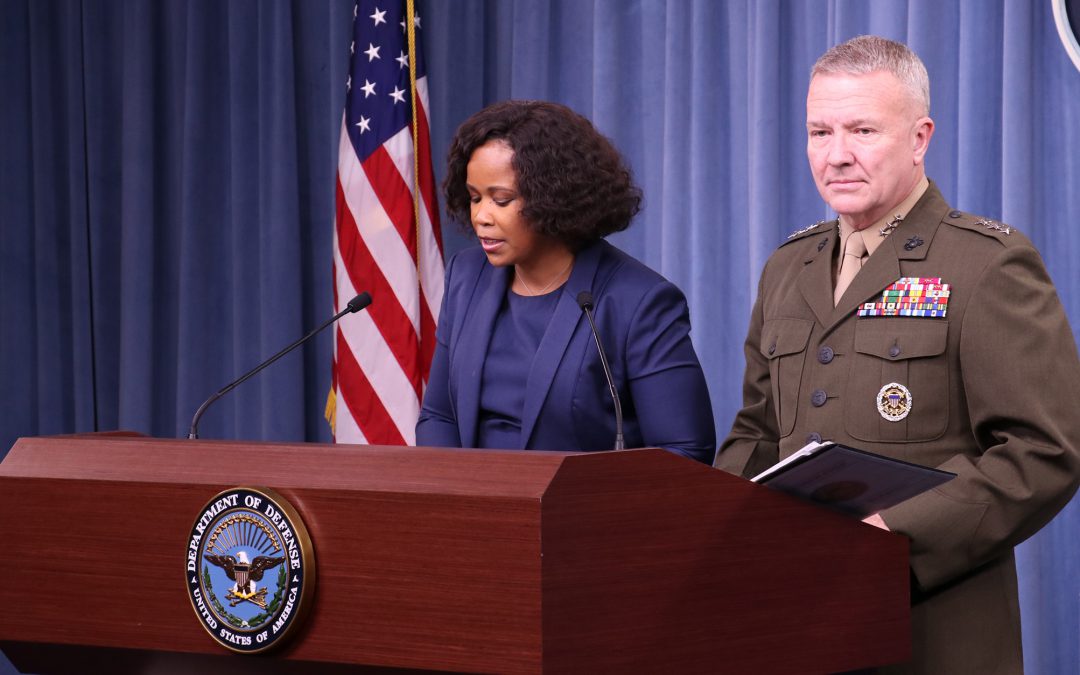WASHINGTON – As the possibility of a government shutdown loomed over Congress and the country, President Donald Trump stressed the importance of keeping the military operating and funded as the basis for getting a budget or another temporary spending bill passed.
Trump, who spoke to reporters in front of the Pentagon Thursday morning, said that the military has the most to lose in the event of a government shutdown and the lack of an enacted, fully-funded budget would undermine military preparedness.
Congress has already put off final action on a new fiscal 2018 budget three times since late last September. The administration and analysts say that a fourth stop-gap spending bill could complicate administration plans to beef up military personnel and build new military ships and aircraft, as called for in the latest defense budget.
A continuing resolution or CR would only allow the Defense Department to spend what was approved for FY2017 in an appropriations bill passed in 2016. That $575.7 billion annual figure is about $60 billion less than the administration’s FY2018’s request.
Lauren Fish, a defense strategies expert at the Center for New American Security, said that one of the biggest challenges the Department of Defense faces, even if a continuing resolution is passed, is its inability to do any “plus-ups,” or spending that is beyond last year’s funding level.
“You can’t start new programs, you can’t acquire new systems, any of that stuff is all on hold,” Fish said. She noted, for example, that modernization plans that are laid out in the budget cannot be undertaken without new congressional authorization.
The complications that are presented by short-term spending fixes for DoD would not just be limited to this year. The defense budget for FY 2019 is supposed to be released in early February. For the second years in a row, the department would have to write a budget without any budget caps in place that are mandated under the 2011 Budget Control Act.
Fish also said that not having clarity about the budget complicates the release of a new National Defense Strategy, which is scheduled to be released on Friday. The DoD has said that its 2019 budget is going to be built off of the NDS. If no budget is passed, this could limit the ability to execute plans that are outlined in the defense strategy
The DoD’s proposed budget is currently $645.1 billion, according to the 2018 National Defense Authorization Act. That figure is made up of two separate budget accounts. The first, and the largest, is the operating budget or “base budget” for personnel and equipment that totals $579.3 billion. The second account, called the “Overseas Contingency Operations” budget and totals $65.8 billion.
While the base budget is used to fund many different aspects of DoD, the OCO goes to supporting military operations in places like Afghanistan, Iraq, Syria, and Eastern Europe, according to the Pentagon. Because OCO is considered to be emergency requirements, it is not capped by the 2011 Budget and Control Act, according to a report by the Congressional Research Service.
In the 2018 NDAA, which has been passed by both houses of government and signed into law by the president, Congress authorized spending levels for DoD that are $50 billion higher than what was originally proposed.
However, Fish explained that the NDAA only authorizes the spending. An appropriations bill is required before those funding levels are given to DoD.
Adding to the complication, the NDAA is only one of three numbers that the Pentagon could potentially be given for 2018. Fish said that the NDAA, DoD’s proposed budget, or the budget cap of around $522 billion placed by the budget control act are all on the table and the Pentagon does not know which one will be handed down.
“There is a swing of $100 billion that they don’t, basically know how to plan for the year,” Fish said while explaining the difference between what was authorized by the 2018 NDAA and what the 2018 BCA funding cap is set at.
In the last few months, the Pentagon has become more openly critical of Congress’ inability to pass a budget. The Pentagon’s Chief Spokeswoman, Danna White, begins press conferences with announcing the number of days that the DoD has been on a CR.
At a press conference last Thursday, White called CR’s “wasteful” and “destructive,” saying that there is no ability for the DoD to plan ahead if there is no reliable knowledge of funding levels.
“The longer a C.R. goes, the more damage it does,” White said. “We need budget predictability.”

